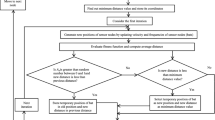Abstract
The problem of node localization in wireless sensor networks aims to assign th e geographical coordinates to each device with unknown position, in the deployment area. In this paper the meta heuristic optimization algorithm known as bat algorithm is described in order to evaluate the precision of node localization problem in wireless sensor networks. Meanwhile the existing bat algorithm has also been modified by using the bacterial foraging strategies of bacterial foraging optimization algorithm. Compared with the existing bat algorithm, the proposed modified bat algorithm is shown through simulations to perform constantly better not only in increasing localization success ratios and fast convergence speed but also enhance its robustness.










Similar content being viewed by others
References
Pal, A. (2010). Localization algorithm in wireless sensor networks: Current approaches and future challenges. Network Protocols and Algorithms, 2(1), 45–73.
Kannan, A., Mao, G., & Vucetic, B. (2006). Simulated annealing based wireless sensor network localization. Journal of Computers, 1(2), 15–22.
Doherty, L. (2001). Convex position estimation in wireless sensor networks. In Twentieth annual joint conference of the IEEE computer and Communication Societies.
Kulkarni, R., Venayagamoorthy, G., & Cheng, M. (2009). Bio-inspired node localization in wireless sensor networks. In Proceedings of IEEE international conference on systems, man, and cybernetics, New York.
Zhang, Q., Wang, J., Jin, C., & Zeng, Q. (2008). Localization algorithm for wireless sensor networks based on genetic simulated annealing algorithm. In International conference on wireless communication networking and mobile computing.
Zhang, Q., Huang, J., Wang, J., Jin, C., Ye, J., & Zhang, W. (2008). A new centralized localization algorithm for wireless sensor network. In Third international conference on communications and networking in China, physical world with pervasive networks.
Li, Y., Xing, J., Yang, Q., & Shi, H. (2009). Localization research based on improved simulated annealing algorithm in WSN. In 5th international communications of conference on wireless communications, networking and mobile computing.
Gopakumar, A., & Jacob, L. (2008). Localization in wireless sensor networks using particle swarm optimization. In IET international conference on wireless, mobile multimedia networks, New York.
Vecchio, M., Valcarce, R. L., & Marcelloni, F. (2012). A two-objective evolutionary approach based on topological constraints for node localization in wireless sensor networks. Applied Soft Computing, 12(7), 1891–1901.
Zhao, Q. S., & Meng, G. Y. (2013). A multidimensional scaling localisation algorithm based on bacterial foraging algorithm. International Journal Wireless and Mobile computing, 6(1), 58–65.
Muller, S., Marchetto, J., Airaghi, S., & Koumoutsakos, P. (2002). Optimization based on bacterial chemotaxis. IEEE Transaction on Evolutionary Computation, 6(1), 16–29.
Yang, X. S. (2011). Bat algorithm for multiobjective optimization. International Journal of Bio-inspired Computation, 3(5), 267–274.
Kim, D. H., & Cho, C. H. (2005). Bacterial foraging based neural network fuzzy learning. In Indian international conference on artificial intelligence.
Author information
Authors and Affiliations
Corresponding author
Rights and permissions
About this article
Cite this article
Goyal, S., Patterh, M.S. Modified Bat Algorithm for Localization of Wireless Sensor Network. Wireless Pers Commun 86, 657–670 (2016). https://doi.org/10.1007/s11277-015-2950-9
Published:
Issue Date:
DOI: https://doi.org/10.1007/s11277-015-2950-9




